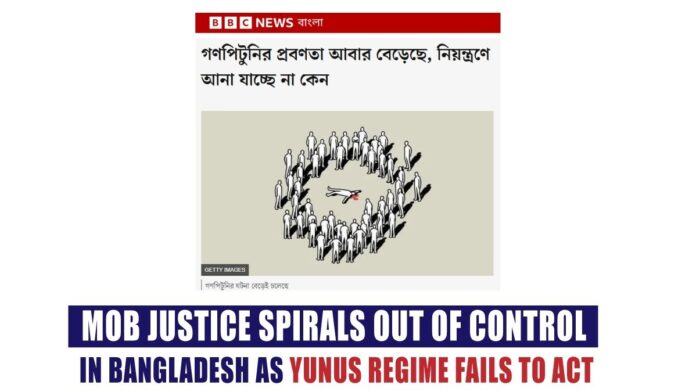Mob violence is once again surging across Bangladesh, spreading like a contagion—with deadly consequences. From the capital Dhaka to rural towns, a growing number of people are being beaten, tortured, and in some cases killed, often on flimsy suspicion or fueled by rumor and public outrage. Viral videos of these lynchings—some involving killings in front of children—are now flooding social media.
In a recent case that shocked the nation, two brothers were beaten to death in Narsingdi on mere suspicion of theft. Elsewhere, a father was savagely attacked in front of his three-year-old daughter because bystanders thought the child’s cries meant she was being abducted.
According to Human Rights Support Society, at least 119 people were killed in mob beatings from August 2023 to March 2024. This year alone, the death toll has already hit 179—the highest in a decade. The Manabadhikar Sanskriti Foundation (MSF) reports that in March 2025 alone, 13 people were killed and 56 critically injured in 39 separate mob attacks.
Experts point to a breakdown in law enforcement, total impunity, and absence of local government institutions since the fall of the previous regime on August 5. What began as political collapse has now spiraled into unchecked lawlessness.
“There is zero success in delivering justice in mob lynching cases,” said Dr. Tawhidul Haque, a criminologist at Dhaka University. “These crimes are not being treated as crimes. That failure fuels repetition.”
MSF Executive Director and lawyer Saeedur Rahman adds, “The police are inactive. People believe mob justice carries no consequences. And they’re often right. Justice is absent. So violence thrives.”
Despite police assurances that they act whenever an incident occurs, there is little evidence of proactive prevention or accountability. A prior police headquarters memo declared that no one has the right to take the law into their own hands, but such statements remain toothless as the violence spreads.
Mob attacks in Bangladesh often begin with a rumor: someone is a thief, a child abductor, a political opponent. The crowd forms quickly. No questions asked, no proof required. Just instant violence. While theft-related cases dominate the headlines, recent months have seen vigilante attacks on people accused of supporting the ousted Hasina administration—suggesting a disturbing political undertone to some of these lynchings.
One disturbing video shows a boy waist-deep in a pond, begging for his life as a mob waits on the bank. When someone jumps in to grab him, he’s dragged out and brutally beaten. His fate remains unknown.
In Kishoreganj, Sohail Mia was attacked in front of his toddler daughter after being falsely suspected of child abduction. The child’s crying—she wanted her mother—was enough to spark mob rage. No one listened. Sohail was beaten unconscious before police intervened.
“There’s now a dangerous trend where mobs claim they are delivering community justice,” said Dr. Haque. “Sometimes people even justify these lynchings online. Others are using it to settle personal scores or extort money. And the absence of swift, decisive state action only emboldens them.”
Rights workers warn that no one is safe. Dozens of videos show helpless victims being dragged, stomped, or clubbed as crowds cheer. In Sylheti Bazar, Kamrangirchar, two men were beaten to death following a local bombing incident—another case of justice delivered by angry citizens.
Bangladesh’s courts have almost no record of punishing perpetrators of mob lynching. Human rights activists say this lack of justice is precisely why the crime is growing.
“The state has effectively abandoned its duty to protect lives,” said Saeedur Rahman. “Mob violence is not just a law enforcement failure—it’s a collapse of the rule of law.”
Dr. Haque likens the rise in mob lynching to an epidemic. “Once it starts, it spreads. If the state doesn’t respond quickly and decisively, it becomes a tool for personal and political violence elsewhere.”
Without urgent legal reform and bold enforcement, Bangladesh may be heading toward a future where fear, rumor, and rage—not justice—rule the streets.
Courtesy: BCC





